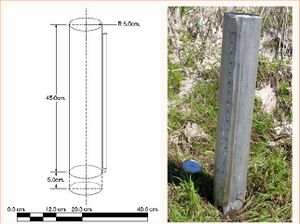
Infiltration design guideline - field verification of site suitability

16.10. Permittees must provide at least one soil boring, test pit or infiltrometer test in the location of the infiltration practice for determining infiltration rates.
Designers should evaluate soil properties during preliminary site layout with the intent of installing infiltration practices on soils with the highest infiltration rates ( hydrologic soil group A and B). Preliminary planning for the location of an infiltration device may be completed using a county soil survey or the NRCS Web Soil Survey. These publications provide HSG information for soils across Minnesota. To ensure long-term performance, however, field soil measurements are desired to provide site-specific data.
If the initial evaluation indicates that an infiltration practice would be a good BMP for the site, it is RECOMMENDED that soil borings or pits be dug within the proposed boundary of the infiltration practice to verify soil types and infiltration capacity characteristics and to determine the depth to groundwater and bedrock. Soil borings for building structural analysis are not acceptable. In all design scenarios, a minimum of one soil boring (two are recommended) shall be completed to a depth 5 feet below the bottom of the proposed infiltration Stormwater Control Measure (SCM or BMP) (Dakota County Soil and Water Conservation District, 2012) per ASTM D1586 (ASTM, 2011). For infiltration SCMs with surface area between 1000 and 5000 square feet, two borings shall be made. Between 5000 and 10000 square feet, three borings are needed, and for systems with greater than 10000 square feet in surface area, 4 or more borings are needed. For each additional 2500 square feet beyond 12,500 square feet, an additional soil boring should be made. Soil borings must be undertaken during the design phase (i.e. prior to the commencement of construction) to determine how extensive the soil testing will be during construction. Borings should be completed using continuous split spoon sampling, with blow counts being recorded to determine the level of compaction of the soil. Soil borings are needed to understand soil types, seasonally high groundwater table elevation, depth to karst, and bedrock elevations.
Recommended number of soil borings, pits or permeameter tests for bioretention design. Designers select one of these methods.
Link to this table
| Surface area of stormwater control measure (BMP)(ft2) | Borings | Pits | Permeameter tests |
|---|---|---|---|
| < 1000 | 1 | 1 | 5 |
| 1000 to 5000 | 2 | 2 | 10 |
| 5000 to 10000 | 3 | 3 | 15 |
| >10000 | 41 | 41 | 202 |
1an additional soil boring or pit should be completed for each additional 2,500 ft2 above 12,500 ft2
2an additional five permeameter tests should be completed for each additional 5,000 ft2 above 15,000 ft2
It is HIGHLY RECOMMENDED that soil profile descriptions be recorded and include the following information for each soil horizon or layer (Source: Site Evaluation for Stormwater Infiltration, Wisconsin Department of Natural Resources Conservation Practice Standards 2004):
- thickness, in inches or decimal feet;
- Munsell soil color notation;
- soil mottle or redoximorphic feature color, abundance, size and contrast;
- USDA soil textural class with rock fragment modifiers;
- soil structure, grade size and shape;
- soil consistence, root abundance and size;
- soil boundary; and
- occurrence of saturated soil, impermeable layers/lenses, ground water, bedrock or disturbed soil.
It is RECOMMENDED that a standard soil boring form be used. A good example is File:Boring Pit Log form.docx. The NRCS Field Book for Describing and Sampling Soils provide detailed information for identifying soil characteristics. Munsell color charts can be found here.
It is HIGHLY RECOMMENDED that the field verification be conducted by a qualified geotechnical professional.
This page was last edited on 27 December 2022, at 19:18.